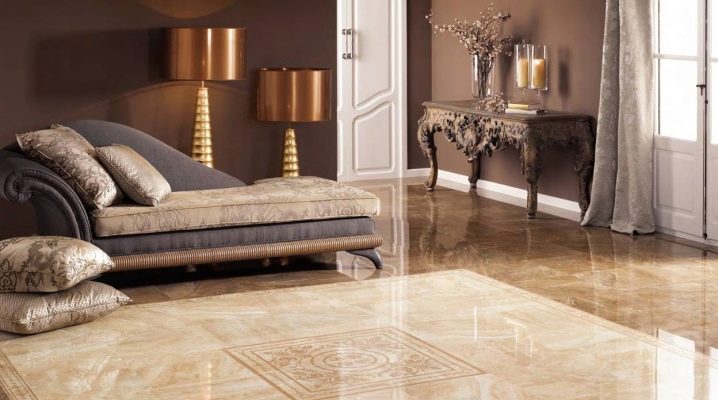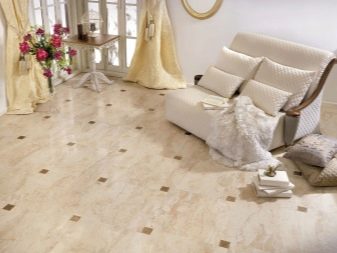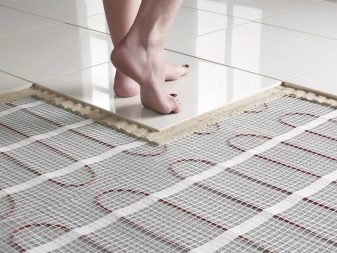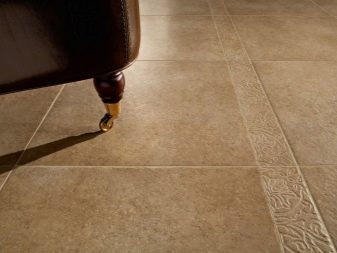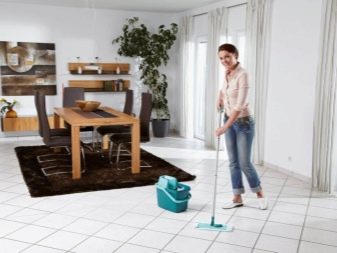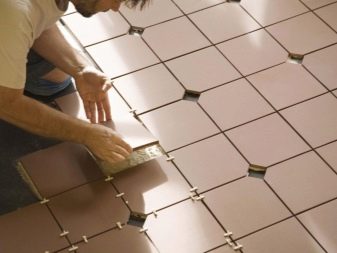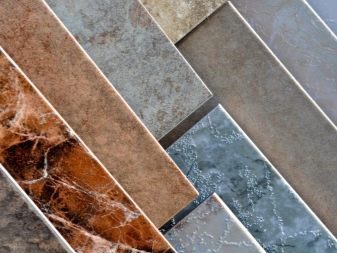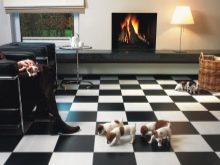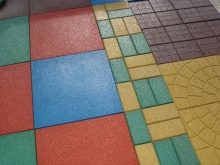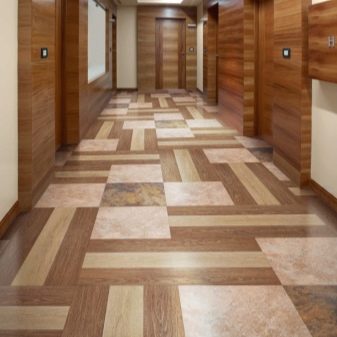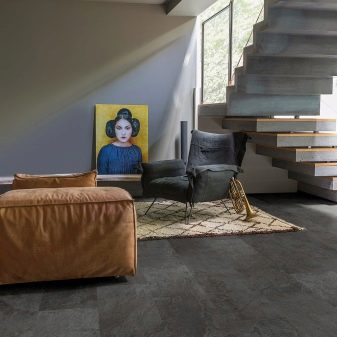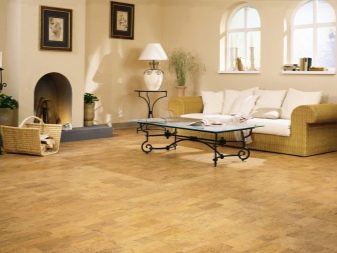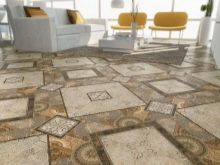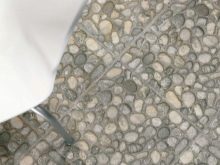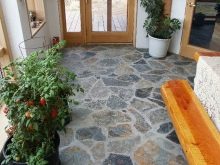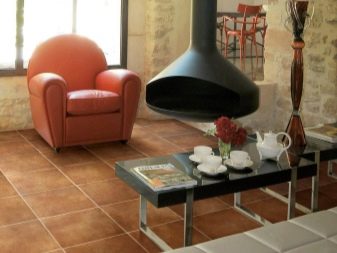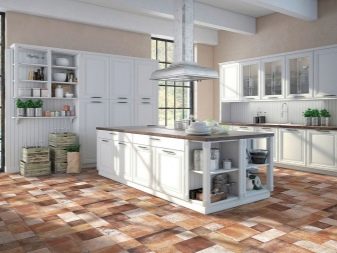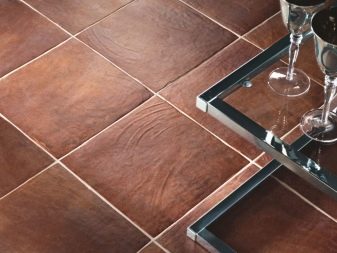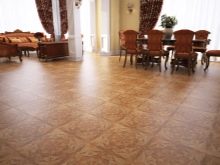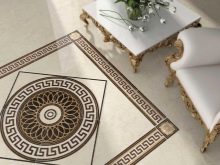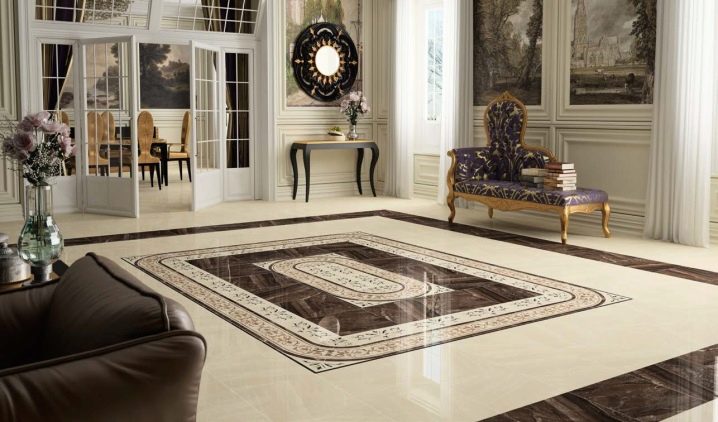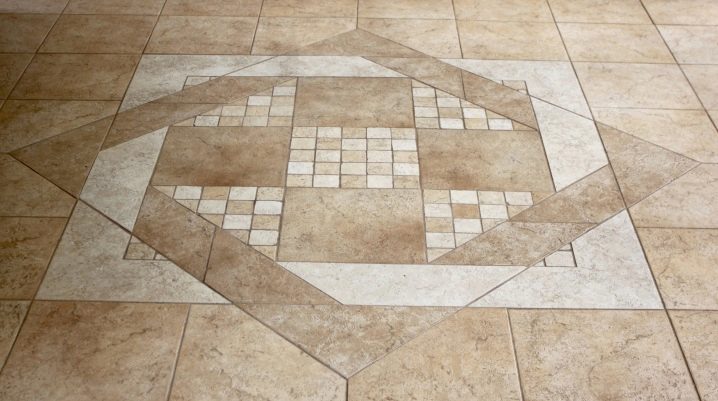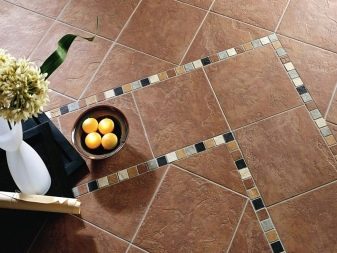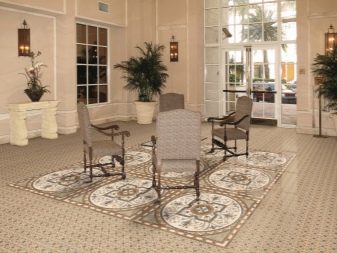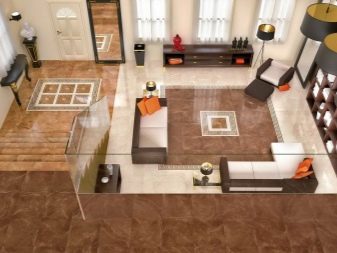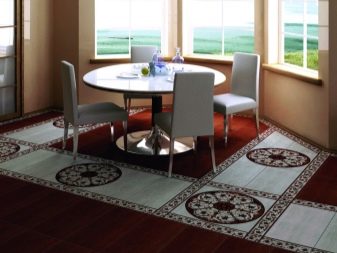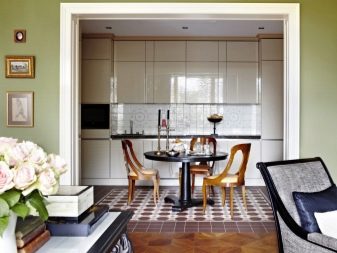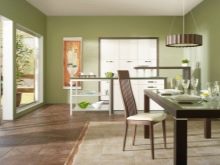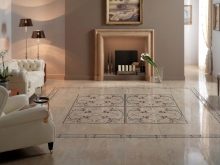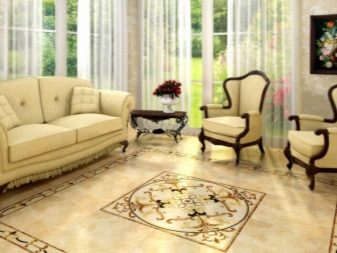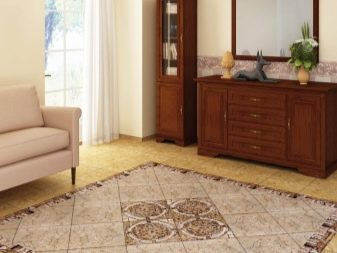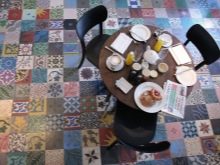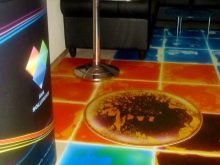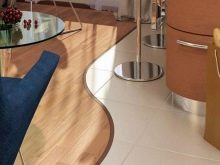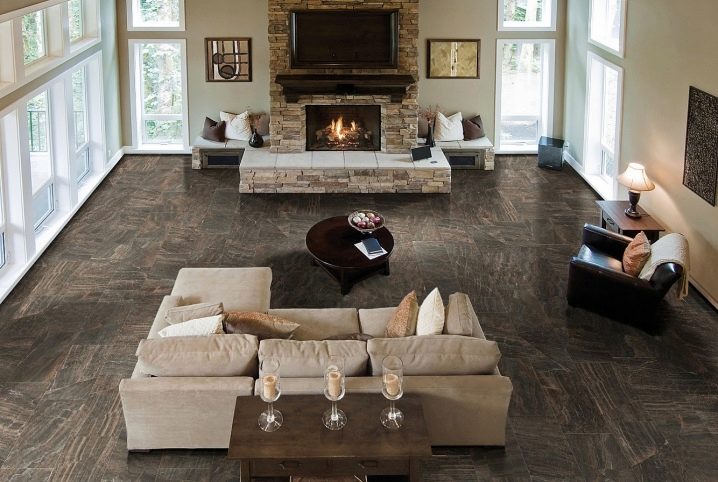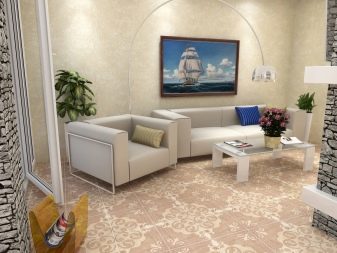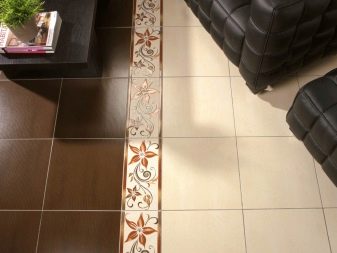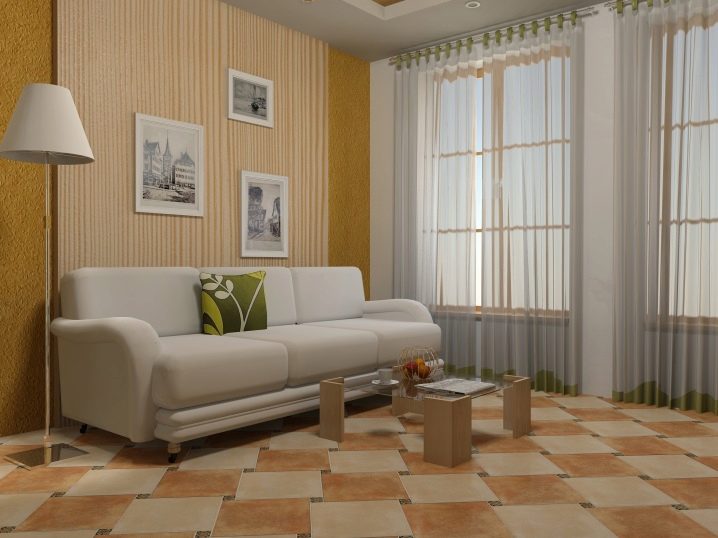Tile on the floor in the living room: practical ideas for the interior
Tile is the original solution for the living room’s flooring. This material is compatible with the "warm floor" system, so this facing has a wide use in the living rooms of the apartment, the houses in which the household members themselves gather, receive guests. This material is quite practical, so it opens up a lot of opportunities for design.
Features and benefits
Placing tiles on the floor is an original design technique that is gaining popularity today. Externally, the material is a fragment of different shapes and colors, by means of which flooring is performed. In fact, the technology is no different from the one used in the walls. The thickness of each part is different: it is noticeably larger, therefore the fragment itself is heavier.
This material has a number of advantages:
- differs in the big term of operation, maintaining the big weight loading and long enough keeping attractive appearance;
- resistant to abrasion, so that is not subject to the formation of scratches on the surface with random mechanical effects;
- some varieties cannot be burned out, retaining the brightness of colors;
- easy to clean and able to withstand daily wet cleaning with the use of abrasives;
- has a wide range of color shades, a noble texture and different types of surfaces, which allows you to add special notes to the interior of the living room for each stylistic design direction;
- it is made of different materials, therefore it has varieties with inherent performance characteristics for each type;
- it is simple in installation, it can be executed independently, without attracting a specialist;
- Depending on the type of raw materials, the complexity of the picture, the size of the fragment, the status of the brand, it is different in cost, allowing each customer to choose the most appropriate option according to his taste and budget.
disadvantages
This material has several disadvantages:
- in the cold season, some varieties are uncomfortable for the feet, so you cannot do without the use of additional heating;
- surface "under glass" sometimes slip, which can provoke a fall;
- Not every material is pleasant to touch: it can be accompanied by a distinctive ringing sound.
Kinds
The floor tile is presented in several types of material, depending on which species are distinguished:
- Vinyl. Sufficiently resistant to shock and mechanical loads tile capable of decorating the floor 10-35 years. Resistant to moisture;
- Rubber. Variety with a pleasant to the touch coating, connecting through special sleeves, but when heated, has a peculiar smell;
- PVC One of their contradictory varieties that needs special care. It is capable of reacting to high temperatures, although with proper handling it is durable;
- Quartzvinyl. Eco-friendly material based on quartz powder is durable, reliable and practical, does not pass moisture;
- Corkboard. Eco-friendly material based on crumbs crumbs does not pass moisture, saves heat and isolates the floor from excessive noise;
- Ceramic. Classical clay-based variety made by roasting (cold material);
- Made of stone Natural cladding material with high wear resistance, strength and durability, needs proper care.
Each type has its own characteristics and advantages.
More often than others in the installation of used ceramic tiles, which is divided into 4 types:
- metlahskaya - without glaze, performed with a single firing;
- kotto - without a layer of enamel, is made on the basis of clay, with a large thickness (up to 3 cm);
- clinker - clay material with inclusions of fireclay, flux, pigments;
- porcelain stoneware (ceramic) - extruded fragments from feldspar dough, quartz, kaolin.
Of these, cotto is more porous, so it is used less frequently in the living room than others. Porcelain stoneware inherent in the gloss of parts, the surface looks like glass. Cork variety is unstable to high loads.
Color and texture
Color solutions for floor tiles are multifaceted and depend on the taste preferences of customers. For those who like light colors, companies offer materials in light beige, wood colors.Popular shades of decoration today are shades of light oak, wenge and Sonoma.
Practical are coffee, brown tones, terracotta, sandy yellow, gray-brick and stone shades.
Black color for the floor is irrelevant: it visually reduces the height of the walls, brings heaviness into the living room space, even if it is diluted in the cladding with light fragments or patterns. Among the interesting and practical solutions are attractive gray-mint, smoky-blue and turquoise shades of a color palette. Diluted with contrasting sandy or milky tones, such paints harmoniously fit into the interior of the hall, look soft and do not interrupt the general idea of the design.
The texture of the floor tile is different. If before it was mostly glossy, today companies offer for sale beautiful options with a matte, rough coating and relief, as well as the effect of 3D. The buyer has the opportunity to make his own choice, choose the material, taking into account the lighting of the room, its overall style and color type.
Montage ideas
The use of floor tiles in the interior of the living room today is subject to several design techniques.A simple one-color coating without a pattern or with a simple print is boring. Since the living room itself is a special room of the dwelling, then the atmosphere in it should be appropriate. Given the fact that this room is an area with high traffic, the use of tiles is a good and practical solution. Modern manufacturers keep up with fashion trends: they develop companion materials. The series includes fragments with the same background and different patterns: for example, for cladding, you can buy monochromatic tiles and exactly the same background, but with a pattern. From the tile, you can perform drawings of varying complexity.
In addition, an interesting technique is to combine the material with a different floor finish: for example, you can use the space zoning technique, giving each functional area of the living room its own purpose. For example, it is possible to allocate a tile lunch or chimney zones.
A few original ideas are worth mentioning:
- In the living room with a bay window, you can focus on the contrast tile in the dining area. It is stylish, practical and beautiful, because the pattern in the tone of the furniture looks harmonious;
- You can perform stacking over the entire area of the monochrome interior by selecting the option with an ornament. He will save the space from boredom and bring cheerfulness to it;
- If preference is given to light tones, then it is worth beating the area of greater permeability by imitating carpet, using fragments with a pattern for the central part of the hall, borders;
- The color of the floor can be made contrasting by completing the finishing in different directions: for example, the main material should be laid at a right angle, the carpet imitation should be done diagonally, decorating the edges with a wide edging, and the center with an original pattern;
- Fans of country style will love the patchwork technique. You can veneer the fragments of the same size, but in different colors, choosing muted tones of sand, coral, blue, wine, marsh flowers;
- You can combine tile with laminate by making a curly line and closing it with an elastic threshold. This will give the living room a special mood, and the practicality of the decoration will remain high;
- If you want creativity, you can perform the laying of the so-called "live" tiles, which reacts to each touch and step, changing the pattern and color.This technique will especially appeal to connoisseurs of glamor and brightness.
How to choose?
In order to purchase building materials for the living room to be successful, you need to take into account several useful recommendations:
- consider a heating system before installation. Not every material needs it;
- consider the layout and size of the room. For a small hall, small fragments are needed, and vice versa;
- add 10% to the purchased quantity of material. During the work a marriage is possible, so the material does not buy butt;
- coloring with a pattern is more practical. It is not so noticeable effects of mechanical damage and chips, which appeared in the process of careless operation;
- combine material. Buy tile duet, laying out different patterns from materials of one series. So the floor will be original;
- the color of the material should be combined with the general idea of style. Vibrant contrasts are unacceptable, interrupting the chosen design theme;
- consider the nuance: the seams are the "sore spot" of the tile. The larger the fragments, the greater the thickness of the seams;
- if possible, eliminate the material with a gloss, so as not to slide on the floor;
- When buying material for a combination with another flooring, select the style immediately and moldings or other connecting elements to mask the seams;
- Choose materials from a trusted manufacturer from its official suppliers.
Reviews
Floor tiles are in great demand for decorating the living room floor. This is evidenced by the numerous reviews left on the Internet. Homeowners consider this finish to be original. It is practical, easy to clean and looks very impressive in a different interior. In some cases, there is a slight decrease in the brightness of the lining, which has long been exposed to sunlight. According to users, this applies to vinyl and quartz vinyl varieties. They write about cork tile that it is rather unstable to weight loads: traces of heels and furniture legs may remain on it.
How to put a new tile on the previous one, see in the next video.
